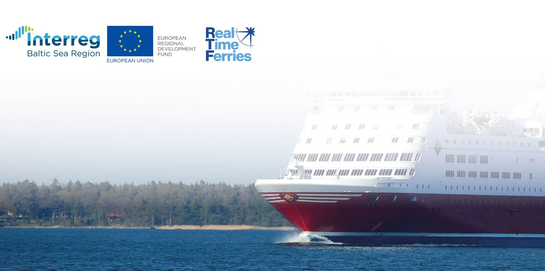
"RTF -Using ferry real time information to optimise intermodal transport chains in the Baltic Sea Region" project extends the generation, deployment and use of ferry real time traffic information in the Baltic Sea Region. It will improve efficiency of intermodal traffic chains that include ferry trips and increase their competiveness for transportation of goods & people in the BSR. Relevant transport actors (i.e. shipping companies, terminal operators, forwarders,stevedores, customs & port authorities,public transport providers, bus operators, satnavproviders etc.) are supplied with a base infrastructure and replicable model applications.Those will enable and motivate them to improve their processes and services related to ferry transportation.
On this purpose, partners from three “domains” (ship navigation / public transport /logistics & ports) start collaborating in the framework of RTF. They bring in existingsolutions from relevant projects & initiatives (esp. INTERFACE PLUS, MonaLisa 2.0 / STMValidation project, EU-Spirit Initiative) to base on. Thus, new real-life infrastructure &applications can be realised within short time.
More specifically, RTF will deliver the following results:
- Transport actors create 5-10 intermodal ferry RT pilotapplications for differentpurposes (e.g. re-routing of goods & people in case of cancellations, “just-in-time”service deliveries in ports in case of delays). Tests on demo lines will clarify andvalidate requirements, potentials and benefits for intermodal transport chains undermarket conditions. Blueprints for replication allow further transport actors to adaptthem for other lines & services.
- A collaborative BSR data hub for ferry real-time info is provided to the transportactors. The EU-Spirit initiative extends its system for this purpose and opens it forfurther users (e.g. ferry companies, logistics companies). It will start serving demolines and first transport actors during the project. Interfaces / connectors,compatibility with prevailing data standards and a “subscribe & plug-in servicepackage” allow others lines and transport actors to use it in medium run, with lowerefforts and at transparent costs.
- 5-10 ferry real-time demonstration lines start working during the project. They willbecome concrete references for replication: The demonstrators depict prevailing BSRferry “line type”. They plug-in to the data hub and test the developed pilot userapplications. Participating key market actors with BSR-wide activities (e.g. StenaLine, DB Schenker) deliver inputs and gain experiences. Thus, the demo lines createa nucleus for further roll out of ferry real-time in the BSR.
- Potential multipliers, financers and investors become aware of benefits of ferry realtime.They are informed about RTF solutions and the concrete user & marketexperiences from the demo lines. Along with subscription possibilities to the hub &replication blueprints, this may open further public funding (e.g. PSOs, nationalfunding), and unlock private investments for ferry real-time.
In summary, RTF will realise concrete base infrastructure investments along with pilotapplications during the project lifetime. They can be directly used (data hub) orreplicated (user applications) by interested parties. On top of improved knowledge andawareness, therefore, the main benefit for transport actors in the BSR is that they mayutilise ferry real-time at much lower costs and less efforts as a result of RTF. The better cost-benefit ratio will facilitate the further roll out in the BSR significantly.
Link to the project: www.realtimeferries.eu/

